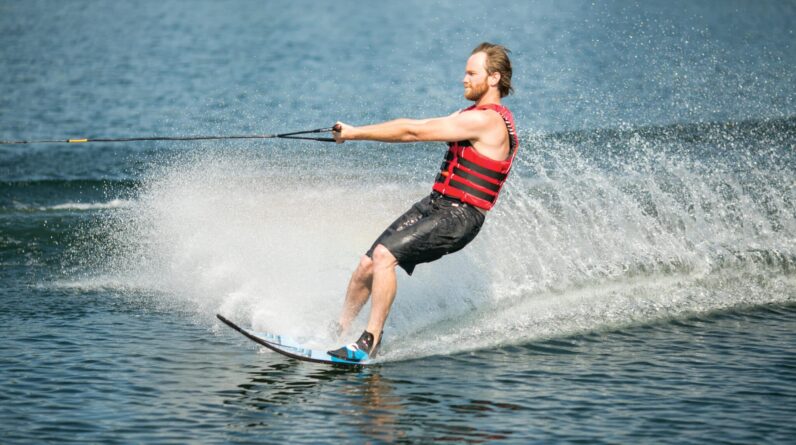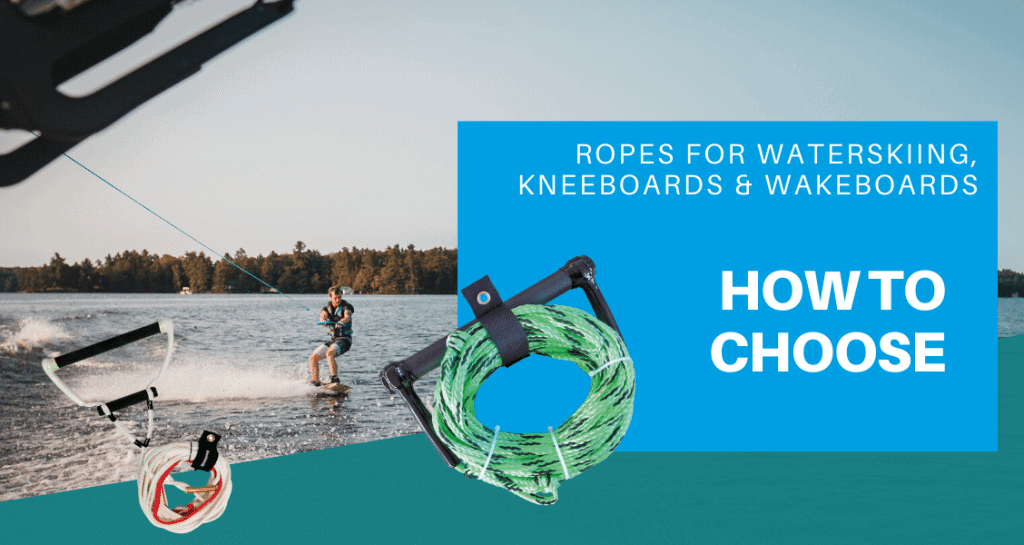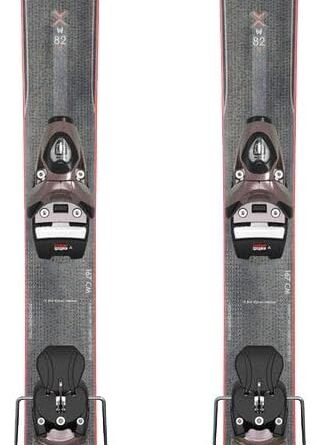
Imagine gliding across the sparkling water, effortlessly slicing through waves as the sun kisses your skin. If you’re a beginner in the world of water skiing, you may be wondering where to start when it comes to choosing the perfect ski rope. Don’t worry, we’ve got you covered! In this beginner’s guide, we will walk you through the process of selecting the right size and style of water ski ropes, ensuring that your next adventure on the waves is safe, enjoyable, and completely unforgettable. So grab your sunscreen and let’s dive in!

This image is property of www.tallingtonlakesproshop.com.
Factors to Consider
When it comes to choosing the right size and style of water ski ropes for beginners, there are several important factors to consider. These factors include the thickness of the rope, the length of the rope, and the material from which the rope is made.
Thickness
The thickness of a water ski rope is an important factor to consider because it can affect the overall performance and comfort of your skiing experience. Thicker ropes generally provide more stability and control, making them easier to handle for beginners. On the other hand, thinner ropes offer less resistance, allowing for faster speeds and more advanced maneuvers. It’s important to find the right balance of thickness that suits your skill level and skiing style.
Length
The length of a water ski rope is another crucial factor to consider. The length of the rope can impact the amount of slack between you and the boat, affecting your ability to navigate turns and jumps. Longer ropes provide more room to maneuver and perform tricks, while shorter ropes offer better control and responsiveness. It is essential to choose a length that matches your skill level and the type of skiing you plan to do.
Material
The material from which a water ski rope is made also plays a significant role in its performance and durability. There are three main types of materials used for water ski ropes: nylon, polyethylene, and hybrid. Each material has its own unique properties and benefits, so it’s important to understand the differences before making a decision.
Types of Water Ski Ropes
There are three main types of water ski ropes: slalom ropes, trick ropes, and combo ropes. Each type of rope is designed for specific skiing styles and offers different features and benefits.
Slalom Ropes
Slalom ropes are designed for slalom skiing, which involves navigating through a series of buoys in a straight line. These ropes are typically thinner and longer than other types and offer minimal stretch for maximum precision. Slalom ropes often have a textured grip to provide better control and reduce hand fatigue.
Trick Ropes
Trick ropes are specifically designed for performing tricks and maneuvers on the water. These ropes are usually thicker and shorter than slalom ropes, offering a more rigid and responsive feel. Trick ropes often have extra features such as handle extensions or additional loops to facilitate advanced tricks and spins.
Combo Ropes
Combo ropes are versatile ropes that can be used for both slalom skiing and recreational skiing. These ropes typically have adjustable sections, allowing you to modify the length of the rope to suit your needs. Combo ropes are a great option for beginners who want to try out different skiing styles without investing in multiple ropes.
Selecting the Right Thickness
The thickness of a water ski rope is an essential factor to consider, especially for beginners. The thickness of the rope can affect your grip strength, control, and overall skiing experience.
Importance of Thickness
Choosing the right thickness is crucial because it can offer stability and control while ensuring a comfortable grip. Thicker ropes provide more surface area to hold onto, making them easier to handle. This can be particularly beneficial for beginners who are still developing their grip strength and control.
Standard Thickness Measurements
Water ski ropes typically come in three standard thickness measurements: 3/8″, 7/16″, and 1/2″. Each thickness measurement offers different levels of performance and suitability for various skiing styles.
The 3/8″ thickness is the thinnest option and is commonly used for slalom skiing. It offers minimal stretch and maximum precision, providing advanced skiers with the responsiveness they need for quick turns and precise control.
The 7/16″ thickness is a versatile option that offers a balance between control and speed. It is often used for recreational skiing and can accommodate a wide range of skill levels.
The 1/2″ thickness is the thickest option and is popular among beginners and recreational skiers. It provides excellent stability and control, making it easier to learn and enjoy the sport.
Best Thickness for Beginners
For beginners, it is generally recommended to start with a 7/16″ or 1/2″ thickness. These thicker ropes offer better stability and control, allowing beginners to focus on their technique without worrying too much about balance or resistance. As beginners gain more experience and skill, they can choose to switch to a thinner rope for more advanced maneuvers and faster speeds.
Determining the Ideal Length
The length of a water ski rope is an important factor to consider as it can greatly impact your skiing experience. The length of the rope determines the amount of slack between you and the boat, affecting your ability to make turns, jumps, and tricks.
Factors Influencing Length Choice
Several factors should be considered when determining the ideal length of a water ski rope. These factors include your skill level, the type of skiing you plan to do, and your personal preferences.
For beginners, a shorter rope is generally recommended. A shorter rope offers better control and responsiveness, making it easier to learn the basics of skiing and build confidence. As beginners progress and become more comfortable on the water, they can then experiment with longer ropes to challenge themselves and explore different skiing styles.
Standard Length Options
Water ski ropes come in various standard length options, ranging from 50 to 75 feet. The length options generally depend on the type of skiing and the skill level of the skier.
For slalom skiing, ropes are typically longer, ranging from 65 to 75 feet. The longer length allows skiers to navigate through the buoys with ease and make smooth, controlled turns.
For recreational skiing and trick skiing, ropes are usually shorter, ranging from 50 to 65 feet. The shorter length provides better control and responsiveness, making it easier to perform tricks and maneuvers.
Recommended Length for Beginners
For beginners, a rope length of around 60 feet is a good starting point. This length offers a balance between control and maneuverability, allowing beginners to learn the basics of skiing while still having room to experiment and progress. As beginners become more comfortable and confident, they can adjust the length according to their preferences and skiing goals.

This image is property of boatworld.co.uk.
Choosing the Appropriate Material
The material from which a water ski rope is made plays a significant role in its performance, durability, and overall user experience. There are three main materials used for water ski ropes: nylon, polyethylene, and hybrid.
Nylon Ropes
Nylon ropes are a popular choice among water skiers due to their durability and resistance to wear and tear. Nylon ropes are known for their ability to stretch and absorb shocks, providing a softer and more comfortable ride. They offer excellent grip and are easy to handle, making them suitable for both beginners and advanced skiers.
Polyethylene Ropes
Polyethylene ropes are lightweight and floatable, making them ideal for recreational skiing and beginners. These ropes have a high tensile strength and minimal stretch, enabling skiers to have better control and responsiveness. Polyethylene ropes are also resistant to UV rays and can withstand harsh weather conditions, ensuring longevity and reliability.
Hybrid Ropes
Hybrid ropes combine the best features of nylon and polyethylene ropes, offering a versatile and high-performance option. These ropes often have a nylon core for durability and stretch, with a polyethylene outer coating for improved control and responsiveness. Hybrid ropes are a great choice for intermediate to advanced skiers who want the benefits of both materials.
Understanding Slalom Ropes
Slalom ropes are specifically designed for slalom skiing, which involves navigating through a series of buoys in a straight line. These ropes offer unique features and benefits that can enhance your slalom skiing experience.
Features and Benefits
Slalom ropes are typically longer and thinner than other types of ropes. The longer length allows for a wider turn radius and smoother, controlled turns. The thinner diameter reduces drag and maximizes precision, providing advanced skiers with the responsiveness and control they need for slalom skiing.
Slalom ropes often have a textured grip pattern to provide better traction and reduce hand fatigue. This allows skiers to maintain a firm grip on the rope even during intense turns and maneuvers.
Suitable for
Slalom ropes are specifically designed for slalom skiers who enjoy the challenge of navigating through buoys in a straight line. These ropes are suitable for intermediate to advanced skiers who have mastered the basics of skiing and want to improve their precision and control.
Recommended Options for Beginners
While slalom ropes are primarily designed for more experienced skiers, there are beginner-friendly options available. These ropes are typically slightly thicker and shorter than standard slalom ropes, offering beginners better stability and control as they learn the ropes of slalom skiing. It’s important for beginners to choose a slalom rope that matches their skill level and allows for gradual progression.

This image is property of blog.overtons.com.
Exploring Trick Ropes
Trick ropes are specially designed for performing tricks and maneuvers on the water. These ropes offer unique features and benefits that enhance your ability to execute advanced tricks.
Features and Benefits
Trick ropes are often thicker and shorter than other types of ropes, providing a more rigid and responsive feel. The extra thickness adds stability and control, allowing skiers to land tricks with confidence. Trick ropes may also have additional features such as handle extensions or additional loops, which facilitate advanced tricks and spins.
Suitable for
Trick ropes are designed for skiers who enjoy performing tricks and advanced maneuvers on the water. These ropes are suitable for intermediate to advanced skiers who have a good level of control and are looking to enhance their trick repertoire.
Recommended Options for Beginners
Beginners who are interested in trick skiing can start with a trick rope that is slightly thicker and shorter than standard trick ropes. These beginner-friendly ropes offer improved stability and control, allowing beginners to learn the basics of trick skiing while minimizing the risk of injury. As beginners gain more experience and skill, they can transition to thinner and shorter trick ropes for more advanced tricks.
Considerations for Combo Ropes
Combo ropes are versatile ropes that can be used for both slalom skiing and recreational skiing. These ropes offer unique features and benefits that make them suitable for skiers who want to engage in different skiing styles.
Features and Benefits
Combo ropes typically have adjustable sections, allowing skiers to modify the length of the rope based on their skiing preferences. This versatility allows skiers to switch between slalom skiing and recreational skiing without having to invest in multiple ropes.
Combo ropes may also offer additional features such as color-coded sections or handle extensions, making it easier to switch between skiing styles and accommodate different skill levels.
Suitable for
Combo ropes are suitable for skiers who want the flexibility to engage in various types of skiing. These ropes are ideal for beginners who are still exploring their skiing preferences and want to try out different styles without committing to a specific rope.
Recommended Options for Beginners
For beginners, combo ropes that have longer sections and provide better control are recommended. These ropes offer a balance between stability and responsiveness, allowing beginners to enjoy both slalom skiing and recreational skiing. As beginners progress and gain more experience, they can adjust the length and sections to suit their skiing style and goals.

This image is property of www.wholesalemarine.com.
Factors to Keep in Mind
When choosing the right size and style of water ski ropes, there are several additional factors to keep in mind.
Budget
Consider your budget when selecting a water ski rope. Ropes range in price depending on their specifications, materials, and brand. It’s important to invest in a high-quality rope that meets your needs and offers durability for long-term use. Remember that a well-maintained and durable rope can last you many skiing seasons.
Skill Level
Your skill level is a crucial factor in selecting the right rope. Beginners should opt for ropes that offer more stability, control, and forgiveness, allowing them to learn and progress comfortably. As your skill level improves, you may choose to upgrade to ropes that cater to your specific skiing style and offer more advanced features.
Boat Type
Consider the type of boat you will be skiing behind. Different boats may require specific ropes or have different recommendations for rope length and thickness. It’s important to check with your boat manufacturer or consult with an expert to ensure you choose a rope that is compatible with your boat.
Additional Tips
Here are a few additional tips to help you choose the right size and style of water ski ropes:
Try Before You Buy
Whenever possible, try out different ropes before making a purchase. Many ski shops and rental facilities offer demo opportunities, allowing you to test various ropes and determine what works best for you. Trying out different ropes will give you a better understanding of thickness, length, and material preferences.
Quality Matters
Invest in a high-quality rope from a reputable brand. Quality ropes not only perform better but also offer greater durability and longevity. A good quality rope will withstand the stresses and strains of skiing, providing you with a more enjoyable and reliable skiing experience.
Consider Accessories
Don’t forget to consider any additional accessories that may enhance your skiing experience. Handles with extra grip padding, protective covers, or rope storage bags are some common accessories to consider. These accessories can improve comfort, prolong the lifespan of your rope, and make transportation and storage easier.
Choosing the right size and style of water ski ropes for beginners is an important decision that can greatly impact your skiing experience. By considering factors such as thickness, length, and material, as well as understanding the features and benefits of different rope types, you can make an informed decision that enhances your skiing skills and enjoyment on the water. Remember to consider your budget, skill level, and boat type, and don’t forget to try before you buy and invest in quality ropes. With the right rope, you’ll be well-equipped to take on the waves and enjoy the thrill of water skiing.

This image is property of arg-images.sunandski.com.






